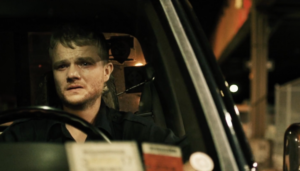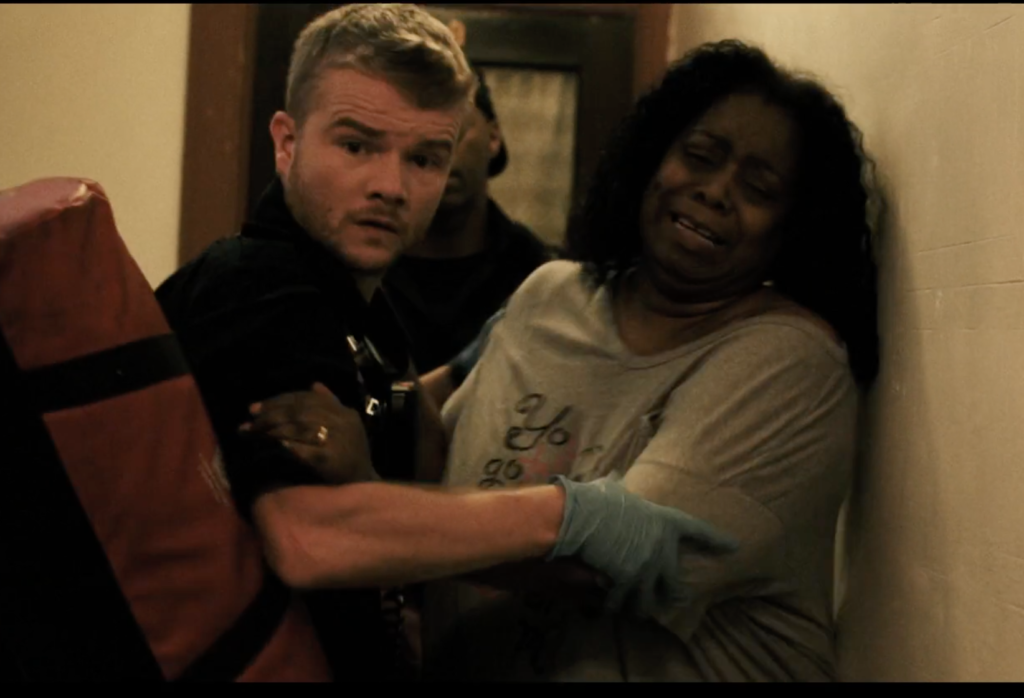Named after the injection administered to revive overdosed heroin addicts, “Narcan” is less about this drug but about paramedics, their lifestyle, and the effect it has on their loved ones. “Narcan” is dark, deep in the right places, and smartly makes allegorical contrasts between assumptions we, as a society, have about both paramedics and drug abusers. Written and directed by Peter McNamara, the film won two separate film festival awards, including ‘Best Narrative Short.’ “Narcan” features capable acting and a focused lens – though its 20 minute run-time may be too short to tie all its pieces together as effectively as it intends.
The film focuses on an Irish-American paramedic named Sean. At the movie’s opening we see he’s a dedicated worker, taking his morning run, silhouetted against the backdrop of NYC before hopping in his truck and driving to work. He holds an envelope in his hand which he regards with deference; amidst this, he listens to a voicemail from a woman who states she “can’t do this anymore” and needs to talk. Reasons for this aren’t quickly presented; in fact they are obscured for most of the film, which causes Sean’s situation to perplex us some as the film progresses. His face strewn with worry at work, his boss, (Anthony Bourray) asks if he’s okay. “Yeah Lou, I’m good.” Lou hesitates, not convinced, repeating his question. Sean responds in his same monotone: “Yeah, I’m good.”
 The film has several strong suits, such as strong cinematography and competent acting, that help it through its run-time. Peter Halpin, who plays Sean, is easy to follow, and his acting comes across as natural and authentic. Halpin did indeed win a ‘Best Actor’ award for his portrayal of Sean at the Williamsburg Independent Film Festival in 2016. His day is filled with things such as driving around the streets of NYC, administering Narcan to a frequently-overdosed addict, as well as working with his partner, Eddie (Shiek Muhmud-Bey), along the way. Muhmud-Bey is also pleasing to watch; we never get the sense we’re watching actors act here, and the result makes the film flow with ease.
The film has several strong suits, such as strong cinematography and competent acting, that help it through its run-time. Peter Halpin, who plays Sean, is easy to follow, and his acting comes across as natural and authentic. Halpin did indeed win a ‘Best Actor’ award for his portrayal of Sean at the Williamsburg Independent Film Festival in 2016. His day is filled with things such as driving around the streets of NYC, administering Narcan to a frequently-overdosed addict, as well as working with his partner, Eddie (Shiek Muhmud-Bey), along the way. Muhmud-Bey is also pleasing to watch; we never get the sense we’re watching actors act here, and the result makes the film flow with ease.
The film’s photography is its high point. Whether it’s featuring shots of the Manhattan skyline, row houses that makes up its neighborhoods, or pans of the paramedic van racing through the streets, it takes us into these people’s lives with precision and care. “Narcan” feels like New York, a credit to the cinematography and film editing done by Fredy Soberanis and Eamonn Clay respectfully.
Two of the film’s most effective shots feature Halpin in scenarios that solidify his character and job: one, as he effectively manages a violent scene in an addict’s house as he revives him after an OD, and a thoughtful shot at the film’s opening, as Sean stares up from a bathtub full of water he has submerged himself in. Coupled with some later details, such as his strained relationship with his wife (Laura O’Shea) and his son Kevin (Harris McNamara, the filmmaker’s son), the message is clear – Sean is drowning, trying to balance his home life with his work one, and is woefully failing.
 My only criticism of the film – which is otherwise shot and acted wonderfully – lies in the presentation of this family strife, which less time is devoted to in favor of Sean’s paramedic arc. We glean some details: Sean has left his wife and son, at least temporarily. His wife understands it has to do with his work; his young son, who laments the lack of his father in his life, does not. A meeting between Sean and his son blurs this further. It’s clear that Sean is torn between wanting to be there for his family and his allegiance to his work (which is shown wonderfully in the film’s close when we find out exactly what Sean’s envelope contains). However, explanations as to why he left in the first place aren’t really presented.
My only criticism of the film – which is otherwise shot and acted wonderfully – lies in the presentation of this family strife, which less time is devoted to in favor of Sean’s paramedic arc. We glean some details: Sean has left his wife and son, at least temporarily. His wife understands it has to do with his work; his young son, who laments the lack of his father in his life, does not. A meeting between Sean and his son blurs this further. It’s clear that Sean is torn between wanting to be there for his family and his allegiance to his work (which is shown wonderfully in the film’s close when we find out exactly what Sean’s envelope contains). However, explanations as to why he left in the first place aren’t really presented.
Overall, “Narcan” is a good film. It highlights the struggle of paramedics to do a job that often involve thankless tasks (in one scene Sean is punched by an addict he revives; in another he is brought to the brink of horror by sights his job privies him to). It makes smart commentary on the use of Narcan without moralizing, taking on stereotypes of drug users and those who aid them in its presentation (while also linking the developments of these scenes to Sean’s personal life). The acting by all involved is solid, and it ends in a believable and heartfelt way. While more depth and character development would have helped the film to excel, we’re still presented with a solid effort by McNamara that is both thoughtful and dramatic.
– by Mark Ziobro


